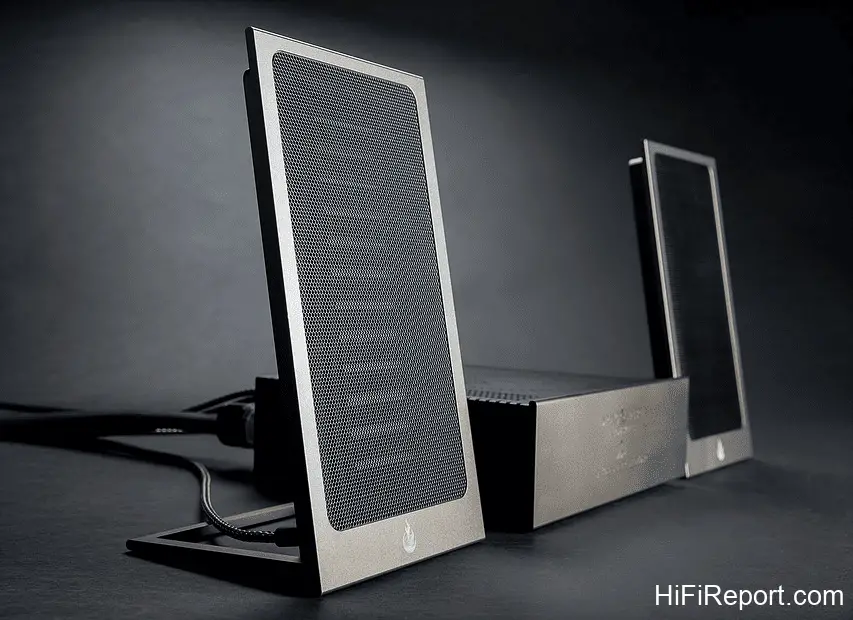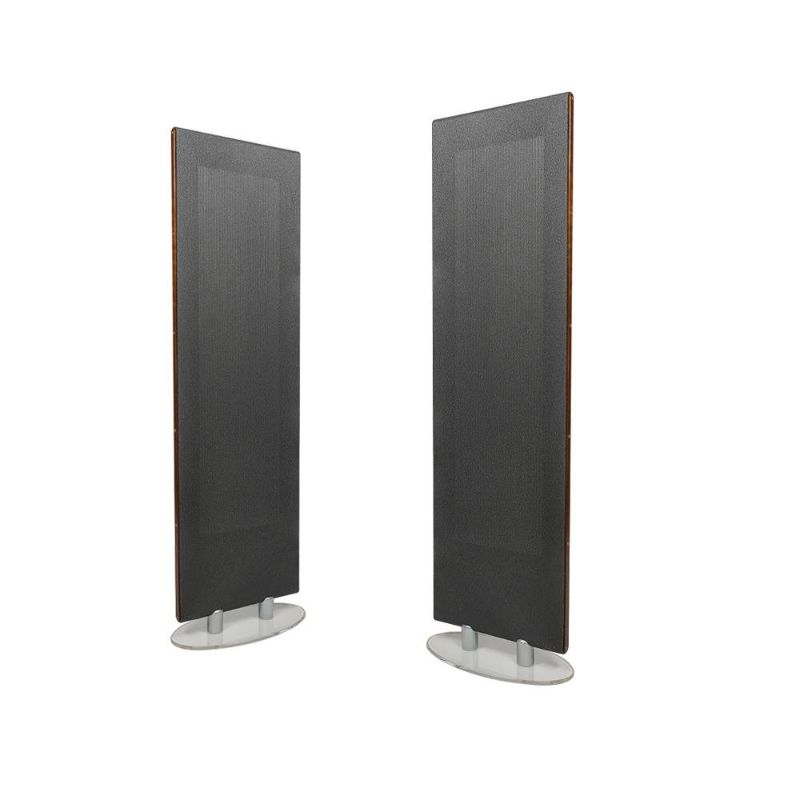Planar Magnetic Speakers: Revolutionizing High-Fidelity Audio
When it comes to audio equipment, high-fidelity audio is the ultimate goal. High-fidelity audio is the reproduction of sound as close to the original recording as possible, with no distortion, noise, or loss of detail. Achieving high-fidelity audio requires the use of high-quality audio equipment, including speakers.
Traditional speaker technology has been around for over a century and has undergone numerous improvements. However, conventional dynamic speakers have limitations, including limited frequency response, low sensitivity, and high distortion. This is where planar magnetic speakers come in.
Planar magnetic speakers are a relatively new technology that has the potential to revolutionize high-fidelity audio. These speakers use a different technology than traditional dynamic speakers and have several potential benefits.
In this blog post, we’ll briefly overview high-fidelity audio and its importance, traditional speaker technology and its limitations, and the potential benefits of planar magnetic speakers.
What are Planar Magnetic Speakers?
Planar magnetic speakers are a type of speaker that uses a different technology than traditional dynamic speakers. Instead of a conventional cone-shaped diaphragm, planar magnetic speakers use a thin, flat diaphragm covered with a pattern of conductors. This diaphragm is suspended between two arrays of magnets, which create a magnetic field that interacts with the conductors on the diaphragm.
When an electrical current is passed through the conductors on the diaphragm, it causes the diaphragm to move back and forth, creating sound waves. Because the diaphragm is very thin and lightweight, it can respond quickly to changes in the electrical signal, resulting in improved transient response.
In comparison to traditional dynamic speakers, planar magnetic speakers have several advantages:
- Because the diaphragm is flat and has a larger surface area than a cone-shaped diaphragm, it can move more air and produce a more detailed sound.
- The magnetic field in a planar magnetic speaker is more evenly distributed, which can result in lower distortion.
- Planar magnetic speakers can have a wider frequency response than traditional dynamic speakers.
The History of Planar Magnetic Speakers
Planar magnetic speaker technology has been around since the 1970s, but it was initially developed for use in headphones. Japanese audio company Fostex developed the first planar magnetic headphones in the early 1970s. These headphones used a thin, flat diaphragm and an array of magnets to produce sound.
In the years that followed, other companies, including Yamaha and Sony, began to develop planar magnetic headphones. These early planar magnetic headphones were popular among audiophiles for their improved transient response and low distortion.
It was in the 1990s that planar magnetic technology began to be used in speakers. The first planar magnetic speakers were developed by the American audio company Magnepan. These speakers used a large, flat diaphragm and an array of magnets to produce sound.
Today, several manufacturers produce planar magnetic speakers, including Magnepan, Audeze, and HiFiMan. These speakers are generally more expensive than traditional dynamic speakers, but many audiophiles consider them worth the extra cost for their improved sound quality.
The future potential for planar magnetic speakers is exciting. As technology improves, planar magnetic speakers, become more affordable and widely available. Additionally, some companies are experimenting with using multiple planar magnetic diaphragms in a single speaker to enhance sound quality further.
Benefits of Planar Magnetic Speakers
Planar magnetic speakers offer several benefits that can significantly improve sound quality. This section will explore some of these benefits and compare them to other speaker technologies.
First, planar magnetic speakers offer improved transient responses compared to traditional dynamic speakers. They can better reproduce fast, dynamic sounds like drums and percussion. Additionally, planar magnetic speakers often have a wider frequency response than active speakers, which means they can produce both low and high frequencies with greater accuracy.
Planar magnetic speakers also have lower distortion than other speaker technologies, such as electrostatic and ribbon drivers. This is because the magnetic field in a planar magnetic speaker is more evenly distributed than in different types of speakers, which results in a more accurate and distortion-free sound.
Compared to electrostatic speakers with a flat diaphragm, planar magnetic speakers can handle higher volumes and have a wider sweet spot. Electrostatic speakers require a high voltage to operate, limiting their output and making them less suitable for larger rooms. Ribbon drivers, which use a thin ribbon of metal as a diaphragm, can also have high distortion and limited frequency response issues.
Overall, planar magnetic speakers offer several benefits, making them an excellent choice for audiophiles who demand the highest quality sound. With their improved transient response, comprehensive frequency response, and low distortion, planar magnetic speakers have the potential to revolutionize high-fidelity audio.
How to Choose a Planar Magnetic Speaker
If you’re in the market for a planar magnetic speaker, consider several factors before purchasing. This section will explore some of these factors and provide an overview of different types of planar magnetic speakers.
One crucial factor to consider is the size of the speaker. Larger speakers can typically handle more power and produce more bass, while smaller speakers may be more suitable for smaller rooms or desktop use. It’s also important to consider the speaker’s sensitivity, measured in decibels (dB) which indicates how loud the speaker can get with a given amount of power. A higher sensitivity rating means the speaker can get louder with less power, benefiting those who want to use a lower-powered amplifier.
Another important consideration is the speaker’s impedance, which refers to the speaker’s resistance to electrical current. Most planar magnetic speakers have an impedance of 4 or 8 ohms, but it’s essential to check the specifications of your amplifier to ensure that it can properly drive the speaker.
There are also different types of planar magnetic speakers to consider. Planar-magnetic-ribbon (PMR) speakers use a thin, ribbon-like diaphragm suspended between two magnetic poles. These speakers are known for their transparency and accuracy but can be expensive and require a powerful amplifier to drive them. Planar-magnetic-dipole (PMD) speakers use a larger, rectangular diaphragm suspended between two magnetic poles. These speakers are more affordable and easier to drive than PMR speakers but may offer a different level of accuracy.
In summary, when choosing a planar magnetic speaker, it’s essential to consider factors such as size, sensitivity, impedance, and the type of planar magnetic technology used. Price is also an important consideration, but it’s important to remember that higher-priced models may offer better sound quality. With careful consideration of these factors, you can find a planar magnetic speaker that meets your needs and delivers the high-fidelity audio experience you want.
Conclusion
In conclusion, planar magnetic speakers are a promising technology that is revolutionizing the world of high-fidelity audio. Planar magnetic speakers offer several advantages, including improved transient response and lower distortion, compared to traditional dynamic speakers. They also have a unique sound signature that many audiophiles find appealing.
While planar magnetic technology has been around for decades, recent advancements have made it more accessible to consumers. There are now several leading manufacturers producing high-quality planar magnetic speakers at various price points, making it easier than ever to experience the benefits of this technology.
When choosing a planar magnetic speaker, it’s essential to consider factors such as size, sensitivity, impedance, and the type of planar magnetic technology used. By considering these factors, you can find a speaker that meets your needs and delivers the high-fidelity audio experience you’re looking for.
Overall, planar magnetic speakers represent a promising development in audio technology. We’re excited to see how this technology continues to evolve and improve in the years to come.
FAQ on planar magnetic speakers
Are planar magnetic speakers suitable for all types of music?
Yes, planar magnetic speakers are suitable for all types of music. They are known for their ability to reproduce music with accuracy and detail, making them ideal for genres such as classical, jazz, and acoustic music. However, they can also handle more complex music, such as rock and electronic, as long as they are paired with a powerful amplifier.
Do planar magnetic speakers require a unique amplifier?
Planar magnetic speakers require an amplifier with enough power to drive them effectively. They have low sensitivity, meaning they need more power to produce the same volume as a traditional speaker. A high-quality amplifier with a high current output is recommended to get the most out of a planar magnetic speaker.
How do planar magnetic speakers compare to electrostatic speakers?
Planar magnetic speakers and electrostatic speakers are both known for their ability to produce detailed and accurate sound. However, planar magnetic speakers are typically more affordable and easier to drive than electrostatic speakers, which require a specialized amplifier. Electrostatic speakers also have a narrower sweet spot and can be more difficult to position properly in a room.
Can planar magnetic speakers be used for home theater systems?
Yes, planar magnetic speakers can be used for home theater systems. They can produce accurate and detailed sound for music and movies. However, choosing a planar magnetic speaker with a comprehensive frequency response and high sensitivity is vital to ensure it can handle the dynamic range of movie soundtracks.
What are some potential drawbacks of planar magnetic speakers?
One potential drawback of planar magnetic speakers is their size and weight. They typically require a larger cabinet to house the magnetic arrays and diaphragm, making them more difficult to position in a room. They also have lower sensitivity than traditional speakers, requiring more power to produce the same volume. Additionally, some listeners may prefer the sound signature of conventional speakers over planar magnetic speakers, which have a unique sound only for some.
Can planar magnetic speakers be used for outdoor events or parties?
Due to their size and sensitivity, planar magnetic speakers are not typically recommended for outdoor events or parties. They are designed for use in a controlled indoor environment where the sound can be appropriately directed and optimized. Outdoor events or parties require more rugged and weather-resistant speakers, such as horn-loaded or coaxial speakers.
How do planar magnetic speakers compare to traditional cone drivers regarding sound quality?
Planar magnetic speakers are known for producing accurate and detailed sound with low distortion, particularly in the midrange frequencies. However, traditional cone drivers can often produce more impactful bass and higher treble frequencies. The choice between planar magnetic speakers and traditional cone drivers ultimately depends on personal preference and the intended use of the speakers.
Are planar magnetic speakers suitable for recording studios?
Yes, planar magnetic speakers can be suitable for recording studios. Their ability to reproduce accurate and detailed sound makes them ideal for critical listening and mixing. However, choosing a planar magnetic speaker with a flat frequency response and low distortion is vital to ensure that the mix translates well to other playback systems.
Can planar magnetic speakers be used in a multi-channel home theater setup?
Planar magnetic speakers can be used in a multi-channel home theater setup. They can produce accurate and detailed sound for music and movies and be used as front, center, or surround speakers. However, choosing a planar magnetic speaker with a comprehensive frequency response and high sensitivity is essential to ensure it can handle the dynamic range of movie soundtracks.
How do planar magnetic speakers compare to ribbon speakers?
Planar magnetic speakers and ribbon speakers are both known for their ability to produce detailed and accurate sounds. However, planar magnetic speakers typically have a larger diaphragm surface area and can handle more power, resulting in more excellent dynamic range and better bass response. Ribbon speakers, on the other hand, are known for their speed and transient response, making them ideal for reproducing complex and fast-paced music.

